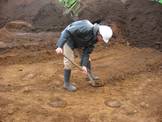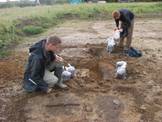160 m of ”the east palisade”
By Steen Wulff Andersen
On October 18 the archaeologists again started work north-east of Jelling Church. In the first days of the week around 160 m of the foundation trench was uncovered of the huge palisade, which enclosed Jelling during the reign of Harald Bluetooth at the end of the Viking period. This is the longest continuous stretch that has been investigated since the foundation trench was first identified during Vejle Museum’s investigations north of the churchyard in 2006. The excavations at the time revealed an opening in the northern side of the palisade, but the supposition that there could be a similar gate on the eastern side was not confirmed. If there was an opening in the eastern palisade then it must have been located further to the south.
The areas inside the north-eastern part of the palisade, where the earth from the summer’s excavations had been deposited, were also opened up. The aim was to establish whether there were further Viking period buildings present in the area, but this did not prove to be the case. One building was identified, but it was of a later date and had no connection to the palisade. However, an extension (a “windbreak”) was identified on the eastern long side of the building, which was uncovered in June within the palisade to the south. This building is now being investigated in detail. The post holes are sectioned so that the “cuts” can be recorded and soil samples are taken for later analysis, which may reveal what the houses were used for.
The excavations are part of a collaboration between the Jelling Project, Vejle Museum and Aarhus University.
October 25 2010





